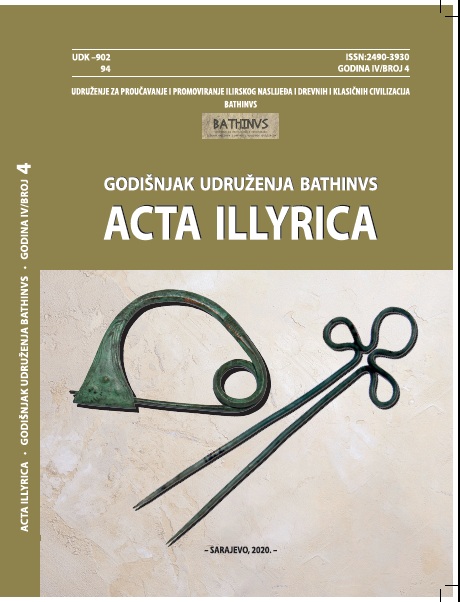Igla kao forma specifične materijalne kulture s kraja bronzanog i početka željeznog doba sjeverne Bosne
Pins as a form of specific material culture from the end of the Bronze Age and the beginning of the Iron Age in the northern Bosnia
Author(s): Aleksandar JašarevićSubject(s): Archaeology, Ethnohistory, Local History / Microhistory
Published by: Udruženje za proučavanje i promoviranje ilirskog naslijeđa i drevnih i klasičnih civilizacija “BATHINVS”
Keywords: northern Bosnia;Early Iron Age;pins;women;mobility;costume;
Summary/Abstract: During the final stages of the Late Bronze Age the territory of northern Bosnia was characterised by remarkable cultural dynamics, visible primarily in the distribution of metal finds: weapons, tools, jewelry, and functional costume objects. The new type of funeral practice – inhumation – emerged here and was perhaps an important factor in the formation and social stratification of communities living here at the end of the Late Bronze Age and the beginning of the Early Iron Age. The area of northern Bosnia is situated between the Pannonian Basin to the north and the mountainous region of the western Balkans to the south commonly referred to as Dinarides. Thanks to its geographical location, the upper course of the Sava River facilitates direct connections with the Alps, while its lower course leads to the Danube that creates a link with the Black Sea region. To the north, the area is open to the wide peripanon regions of Slavonia and Syrmia. Up the Danube valley, the communication corridor reaches Transdanubia and,along the Tisza River, the central part of the Carpathian Basin. This paper presents a specific form of material culture, a bronze pins with disk-shaped head and short thickening on the neck. A total of six pins are known; two of which have been discovered in hoards (Osredak and Gajina pećina), one in a grave (Ostrožac near Cazin), while the remaining pins are chance finds (Donja Dolina, Prud, and Soukbunar). They all come from a very limited region south of the Sava River and chronologically cover the period from the10th to the end of the 9th century BC or with Ha B2/3 horizon of Central European periodization. The pins with a disk-shaped head and short thickening on the neck most likely became part of women’s headgear or complex hairstyles, suggesting the development of special local habits and dress codes intended to promote status and rank. The choice of jewellery and local costume of the females yields information on their origins, affiliations,status, and social and economic role within the community. This paper posits that female costume in nothern Bosnia played the role of an important medium of social communication and interaction, and that it was important for the self-identification of its wearer in identifying their status. Furthermore, women’s mobility played an important role in spreading cultural habits at the end of the Late Bronze Age and in the Early Iron Age in the Western Balkans, with such mobility being evidenced through the distribution of personal items, especially jewellery and ornaments. Reasons for this mobility are related to economic, artisanal, military-political, ritual, and other various practices of the time. A special place in these exchanges was afforded to women, who, through exogamous marriages, became visible in the processes of cultural and social interaction.
Journal: Godišnjak Udruženja BATHINVS “Acta Illyrica”
- Issue Year: 4/2020
- Issue No: 4
- Page Range: 49-66
- Page Count: 18
- Language: Serbian

